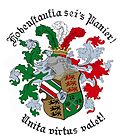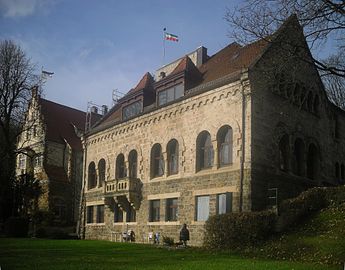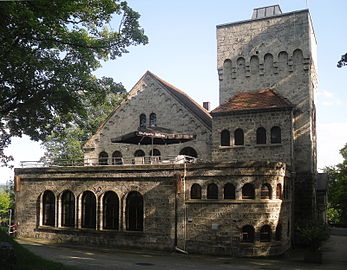Gymnastics Association Hohenstaufia Tübingen
|
Gymnastics Association Hohenstaufia in the CC in Tübingen |
||||||||||
|---|---|---|---|---|---|---|---|---|---|---|
| coat of arms | Circle | |||||||||

|

|
|||||||||
| Basic data | ||||||||||
| University / s: | Eberhard Karls University of Tübingen | |||||||||
| Place of foundation: | Tübingen | |||||||||
| Foundation date: | December 10, 1878 | |||||||||
| Corporation association : | Coburg Convent | |||||||||
| Colours: |
|
|||||||||
| Type of Confederation: | Men's association | |||||||||
| Position to the scale : | mandatory | |||||||||
| Motto: | ' Unita virtus valet!' | |||||||||
| Website: | www.hohenstaufia.de | |||||||||
The Gymnastics Association Hohenstaufia in the CC zu Tübingen is an obligatory and color-bearing student union that unites students and alumni of the Eberhard Karls University of Tübingen and the Reutlingen University . It was donated in 1878 and is a member of the Coburg Convent (CC).
Couleur, motto
The colors of the Hohenstaufia gymnastics club are green-white-red. Boys wear a green-white-red ribbon with silver percussion, Füxe wear a green -red one with silver percussion. The student cap is green and has a distinctive format, the so-called Tübinger Vollschlapp , which is only used by one other student association. The motto of the Hohenstaufia gymnastics club is Unita virtus valet! (German: United virtue makes you strong! )
history
Hohenstaufia was founded on December 7th, 1878 as a black , non-striking connection Gothland in the Kemmlerei (today Boulanger ) in Colegiumsgasse in the old town of Tübingen . The statutes were established on December 10, 1878, which is the official foundation day of the association. The statutes provided for a harmonious development of mind and body; the gymnastics stand strong in the foreground. Gothland's motto was Virtus, Libertas, Humanitas! The colors chosen were red-white-green (read from below) from the Staufia Abbey, which was dissolved in 1868. In 1879 the new constant was the Hanskarle at Lustnauer Tor , as the premises of the Kemmlerei became too small to accommodate all members of the Federation.
From February 1, 1880 Gothland appeared as a color-bearing connection Hohenstaufia , the colors were reversed and were now green-white-red; the motto was on Unita virtus valet! changed. Although there was already a lot of fighting back then, gymnastics was still formally in the foreground. It was not until 1884 that fencing became official and gymnastics optional; In 1885 unconditional satisfaction was also introduced, which reflected the general trend among student associations during this period. In 1896 Hohenstaufia entered the representative convention of German gymnastics associations (VC). In 1897 the federal government was renamed the Hohenstaufia gymnastics club .
From July 23, 1914 to December 17, 1919, the First World War practically came to a standstill; many Hohenstaufen died in the war. After the resumption of fraternal life, however, the situation was successfully overcome with numerous new entrants.
In 1920 there was a dispute over fencing issues with the Eberhardina gymnastics club, which came before the court of honor of the VC in Marburg . As a result, both leagues were diminished , but Hohenstaufia was only resumed after a year. Since the gymnastics fraternity was without a fixed paucity ratio at that time , the Strasbourg gymnastics fraternity was founded as a subsidiary in order to be able to find enough games.
In the course of the Nazi dictatorship against student associations, Hohenstaufia dissolved in 1936 as one of the last remaining associations in Tübingen. In order to make a halfway federal life possible, 113 Hohenstaufen of the Comradeship Dietrich-Eckhart (the names of these "comradeships" were given by the NSDAP ) entered the house of the Turnerschaft Palatia. The official re-establishment of Hohenstaufia took place on November 10, 1948 in the Hirsch in Derendingen . 1953 also took place the union with the gymnastics club Strasbourg.
Hohenstaufia and Josef Buchhorn
In 1897 Josef Buchhorn became active at Hohenstaufia . In 1906, the song he had written for Hohenstaufia for Hohenstaufia was sung by the foxes for the first time , when the violets bloom (setting by Otto Lob ). Within a few years, the song established itself as a student anthem at all German universities and is still one of the most important and well-known for German student songs .
To be a student initially counted four stanzas, after the First World War Buchhorn added a fifth in honor of his fallen federal brothers.
Buchhorn is also the author of the successful novel Die Hohenstaufen, a Tübingen student novel (1908), which depicts Hohenstaufia's federal life and is the first literary description of a gymnastics community, as well as other books and poems that deal with liaison.
Fraternity house
Already at the beginning of the 1890s the construction of a connection house was discussed, also based on the first sketches. Concrete steps were taken in 1900 when a house building commission was founded; In the same year, the previous constant, the Hanskarle, was torn down in order to build a new road on the Österberg . In 1901 the house building association was founded, which acquired a plot of land on the Österberg. The actual construction began in February 1902; After eight months, the house , built in neo-Romanesque style, was completed in October 1902. The style of the Hohenstaufenhaus is based on the representative German architecture from the Middle Ages, more precisely on the imperial palaces of the Hohenstaufen dynasty .
The garden was considerably expanded in 1910 and 1913 through the purchase of parcels; in the 1920s renovations were carried out on the house to create larger rooms for the festive occasions of the association. After Hohenstaufia was dissolved during the Nazi dictatorship, the building went to the Reichsstudentenwerk and was used by various Nazi party organizations during the Second World War; after the end of the war it was occupied by the French army, like most of the other fraternity houses on the Österberg. Hohenstaufia got the liaison house back in 1951 through a legally binding partial recognition judgment, but the factual takeover from the French occupying power did not take place until October 8, 1952. The interior of the house was almost completely cleared out, and an enormous refurbishment had to be undertaken in the years that followed. Today the house of the Hohenstaufia gymnastics club is a listed building .
The student residence opposite the Hohenstaufenhaus, which was completed in 1998 and which is inhabited by parts of the Aktivitas as well as by external students, is atypical for a student association.
Friendship relationships
Hohenstaufia maintains friendships with three other student associations.
- since 1892: Old Leipzig gymnastics club Hansea in the CC in Bielefeld, is considered the oldest friendship within the Coburg Convent
- since 1955: Old Leipzig Gymnastics Association Fridericiana in the CC in Mannheim / Heidelberg
- since 1955: AV Amicitia San Gallensis in St.Gallen
Known members
In alphabetic order:
- Otto Barth (1881–1947), senior administrator and district administrator in Württemberg
- Kurt Breucker (1934), judge of the State Security Senate at the Stuttgart Higher Regional Court during various trials against members of the Red Army parliamentary group
- Bernhard Beyer (1879–1966), neurologist
- Josef Buchhorn (1875–1954), journalist, writer, politician
- Elmar Doch (1910–1971), local politician
- Walter Erbe (1909–1967), professor for Roman and civil law at the Eberhard Karls University of Tübingen , chairman of the Friedrich Naumann Foundation and the Institute for Foreign Relations , Politicians (DVP / FDP)
- Max Gasser (lawyer) (1886–1961), President of the Regional Court
- Karl Hermann Jacob-Friesen (1886–1960), prehistorian , archaeologist, university professor and director of the Lower Saxony State Museum in Hanover
- Theodor Liesching (1865–1922), lawyer and politician, last royal Wuerttemberg Prime Minister, then Minister of Finance MdL
- Otto-Günter Lonhard (1933), President of the Baden-Württemberg Court of Auditors, Swabian homeland researcher
- Helmut Naunin (1904–2002) administrative lawyer, publicist
- Hermann Röger (1883–1954), senior administrator and district administrator in Württemberg
- Emil von Sauer (1889–1967), lawyer, first president of the German Lawyers' Association (DAV) after the Second World War
- Friedrich Schäfer (1915–1988), politician, parliamentary manager of the SPD parliamentary group 1961–1966, State Secretary in the Federal Ministry for Affairs of the Federal Council and the Länder
- Theodor Schenk (1894–1945), district administrator in Schorndorf
- Wilhelm Schneider (1910–2003), dermatologist, full professor in Tübingen
- Heinz-Eugen Schramm (1918–1998), author, editor
Historical photos
Stupid boy by W. Hornung , Tübingen
See also
Individual evidence
- ^ Martin Biastoch: Tübingen students in the empire. A socio-historical investigation . Sigmaringen: Jan Thorbecke 1996, p. 140, ISBN 3-7995-3236-6 (= Contubernium - Tübingen contributions to the history of universities and science, vol. 44)
- ^ EH Eberhard: Handbook of the student liaison system. Leipzig, 1924/25, p. 110.
- ↑ George Dehio , Dagmar Zimdars: Handbook of German art monuments: Baden-Württemberg II - administrative districts of Freiburg and Tübingen . Deutscher Kunstverlag , Berlin, Munich 1997, p. 729, ISBN 3422030301
literature
- Martin Biastoch : Tübingen students in the German Empire. A socio-historical investigation . Contubernium - Tübingen Contributions to the History of University and Science Bd. 44. Sigmaringen 1996 ISBN 3-51508-022-8
- Michael Doeberl et al. (Ed.): Academic Germany. Volume 2: The German universities and their academic citizens. CA Weller, Berlin 1931. p. 1031.
- Werner Kratsch (ed.): The connection system in Tübingen. Documentation in the year of the university anniversary in 1977. Tübingen 1978. S. 46ff.
- Heinz Kraus: The country teams and gymnastics associations of the Coburg Convent. Student History Association, 1978. pp. 119–120.
- Gymnastics Federation Hohenstaufia zu Tübingen in the CC (Ed.): 130 years Hohenstaufia zu Tübingen (1878-2008) . Editing: Klaus Kirsten. akadpress, Essen 2011.












